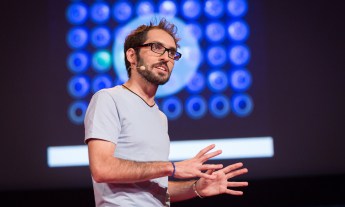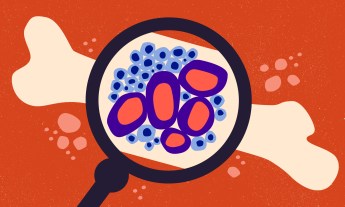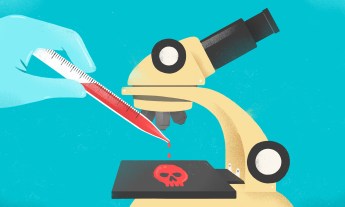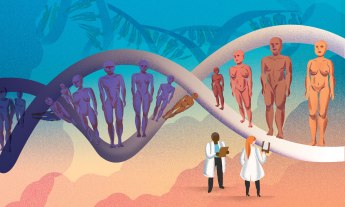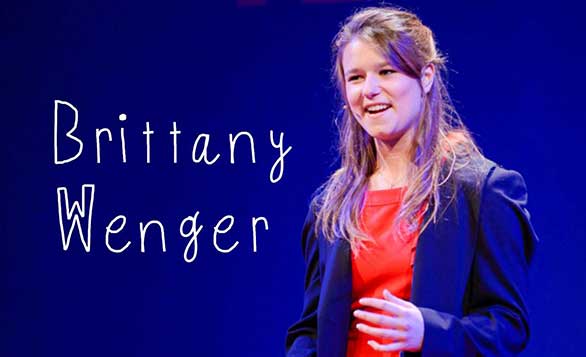
When Brittany Wenger was a sophomore in high school, her cousin was diagnosed with breast cancer. She saw firsthand how the disease strikes a woman and her family, and she wanted to help. While some of us might offer to bake a casserole or lend a listening ear, Brittany went the extra mile: She created a breast cancer test that could someday help millions of women catch the disease early.
Brittany, now a freshman at Duke, is an enthusiastic, articulate young woman who is so well versed in the science she studies that it can be tough to follow her rapid technical explanations. She may still be a teenager, but she’s been conducting impressive research for years. As early as the seventh grade, Wenger was experimenting with advanced computer science and artificial intelligence programs. (She of course taught herself to code.)
From those early experiments, Wenger has gone on to write computer programs that improve the accuracy of tests for breast cancer and leukemia (below, she explains how they work). Her work has been honored by the Intel Science Talent Search, the Google Science Fair, and the Intel International Science and Engineering Fair, and she was just named one of Time Magazine’s 30 under 30. Wenger’s breast cancer test, which has its own app, is now in beta tests with two cancer research centers.
We chatted with Wenger about her first computer program, her impressive research, and some recent words of encouragement from President Barack Obama. Below is an edited version of our conversation.
My first question: When did you first get excited about computer programming? Here’s Brittany —
I had to write a final term paper on any aspect of the future, so I decided that I would write about technologies of the future. I Googled things that may happen fifty, a hundred years from now, and I came across the concept of artificial intelligence. I was just enamored by it. I went home, I bought a coding textbook, and started teaching myself how to code.
What was your first program?
An artificial intelligence program that learned to play soccer. I worked on that for three years.
And were you successful? Did the program learn how to play soccer?
Yeah, and it won about 95 percent of its games.
How do you teach a computer to play the game?
Basically, the program would look up scenarios that it had been in before. So there are x number of players in front of me; I am this far away from a corresponding player; I have the ball; I don’t have the ball. And based on [that information], it would come up with the best response in that situation.
So it was learning as you ran it?
Yeah. Exactly. It was really funny! At first, they played like 4-year-olds. They couldn’t do anything. They would just stand there the whole time.
At what point did you decide to apply your interests in artificial intelligence and computer science to breast cancer?
When my cousin got breast cancer, she was telling me about how difficult the diagnostic process was. I researched and found out about fine needle aspirates, which are the least invasive, quickest and cheapest [diagnostic] procedures that a woman can have. Right now, they’re wildly inconclusive, so a lot of doctors refuse to use them. Only about five hospitals in the United States still use the procedure. I was really interested in trying to revive them, and when I found out that the major problem was how difficult the patterns were for pathologists to diagnose, I wanted to create a tool to aid the doctors.
I have to admit, I’m still a bit mystified about how this breast cancer detector works. Can you break it down for me?
Based on cell morphology, which is how the cells look, the program will look for patterns and try to determine whether a person has cancer or not. For example, multi-layered cells are an indicator that a person may have cancer. It’s a little more complicated than that, though, because masses will exhibit both characteristics of non-cancerous masses and cancerous masses, even though clearly one mass can only be cancer or not cancer.
And does the detector work for all different types of breast cancer?
Right now, the detector is meant to be an initial screening mechanism—it’s trying to go through and determine whether the cells are cancerous or not. If it returns a diagnosis that the cells are cancerous, further testing would be required to determine the specific type.
So it can’t necessarily tell the difference between a fast-growing malignant tumor versus a slow one. This is a step before that.
Exactly. But the program would have the capacity to do that if I had data. For example, I extended the program to work with genetic expression programming and leukemia diagnostics. For that, I actually go through and identify which subtype of leukemia a person had, and then I’m able to infer how aggressive the cancer would be.
What’s happened since you created the breast cancer program?
So much. I think one of the most exciting things that’s happened is doctors have really started taking my research seriously. I’m beta-testing the breast cancer program with two hospitals, which has been incredible. I also got to go to the White House Science Fair and explain my research to President Obama!
What did he say to you?
He had an intense look of concentration on his face, showing me he really cared about [my research], and he said something along the lines of that he was really proud of me. This is the President of the country saying that, so I was really taken aback. I’ll always really treasure those words. And this was also the first election I got to vote in, so I think it made it even more special.
There’s so much talk about the lack of women in science. What has your experience been as a young woman in science?
I’ve always felt empowered to pursue [science]. I had a lot of strong female role models. For example, my computer science teacher in high school was a woman. I was really lucky to grow up in that sort of environment.
Do you have any advice for inventors or entrepreneurs, especially young scientists?
If you find your passion, just follow it and have the persistence to stick through it. I mean, for me, the breast cancer program failed completely two times before it succeeded. But what’s great about science is that you learn a lot from those experiments. They can really help you move forward.
This article is part of a series on young voices, exploring the spirit and wisdom of youth. Read the full series here.
Brooke Borel is a frequent contributor to TED.









